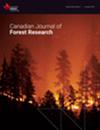Residual canopy cover provides buffering of near-surface temperatures, but benefits are limited under extreme conditions
IF 1.7
3区 农林科学
Q2 FORESTRY
引用次数: 0
Abstract
Increasing summer temperatures and higher probabilities of extreme heat events have led to concerns about tree damage and mortality. However, insufficient attention has been given to conditions leading to heat-related regeneration failures in temperate forests. To address this managers need to understand how microclimate varies under a range of overstory conditions. We measured air temperatures at 2cm above-ground underneath a gradient of canopy cover on south-facing slopes in recently thinned Douglas-fir stands in western Oregon, USA. To expand the ecological relevance of these data to impacts on regeneration, we created the stress-degree hours (SDH) metric, representing the amount of time - and by how much – temperatures exceeded biologically relevant stress thresholds. Overall, for every 10% increase in canopy cover, maximum temperatures at 2cm were 1.3oC lower, the odds of temperatures exceeding stress thresholds for conifer regeneration declined by a multiplicative factor of 0.26, and the total of SDH decreased by 40%. These reductions are large enough to be worthy of attention when managing for tree regeneration. However, data collected during the Pacific Northwest Heat Dome in June 2021 indicate that with various climate change scenarios and heatwave occurrences, temperatures will be unfavorable for regeneration regardless of overstory cover.残余树冠覆盖可缓冲近地表温度,但在极端条件下效益有限
夏季气温的不断升高和极端高温事件发生概率的增加导致了人们对树木损害和死亡的担忧。然而,人们对温带森林中导致与高温有关的再生失败的条件关注不够。为了解决这个问题,管理者需要了解小气候在一系列上层林木条件下是如何变化的。我们测量了美国俄勒冈州西部最近疏伐的花旗松林南向斜坡上树冠覆盖梯度下地面以上 2 厘米处的气温。为了扩大这些数据对再生影响的生态相关性,我们创建了压力度小时(SDH)指标,代表温度超过生物相关压力阈值的时间和程度。总体而言,树冠覆盖率每增加 10%,2 厘米处的最高温度就会降低 1.3 摄氏度,温度超过针叶树再生压力阈值的几率就会下降 0.26 倍,SDH 的总量就会减少 40%。这些降低幅度很大,值得在管理树木再生时加以注意。然而,2021 年 6 月在西北太平洋热穹期间收集的数据表明,在各种气候变化情景和热浪发生的情况下,无论上层覆盖物如何,温度都将不利于树木再生。
本文章由计算机程序翻译,如有差异,请以英文原文为准。
求助全文
约1分钟内获得全文
求助全文
来源期刊
CiteScore
4.20
自引率
9.10%
发文量
109
审稿时长
3 months
期刊介绍:
Published since 1971, the Canadian Journal of Forest Research is a monthly journal that features articles, reviews, notes and concept papers on a broad spectrum of forest sciences, including biometrics, conservation, disturbances, ecology, economics, entomology, genetics, hydrology, management, nutrient cycling, pathology, physiology, remote sensing, silviculture, social sciences, soils, stand dynamics, and wood science, all in relation to the understanding or management of ecosystem services. It also publishes special issues dedicated to a topic of current interest.

 求助内容:
求助内容: 应助结果提醒方式:
应助结果提醒方式:


